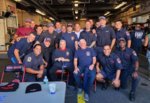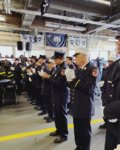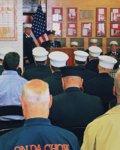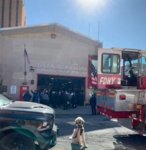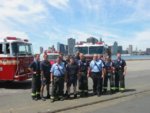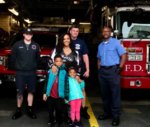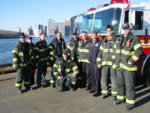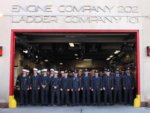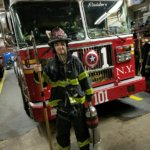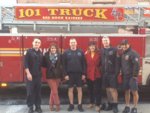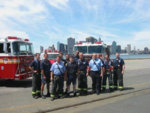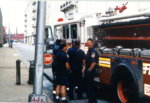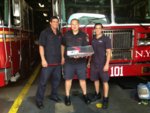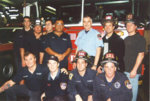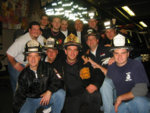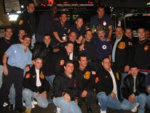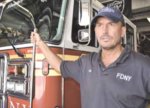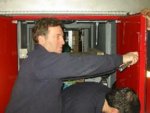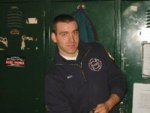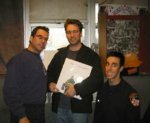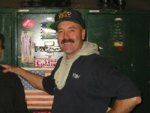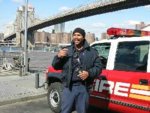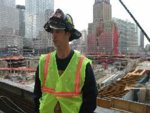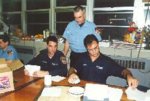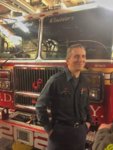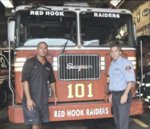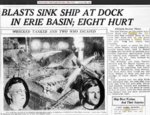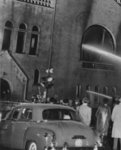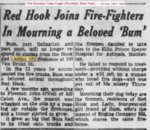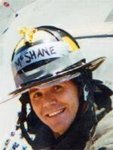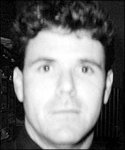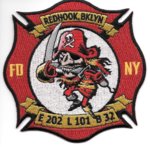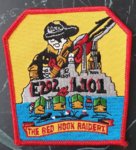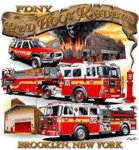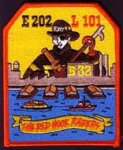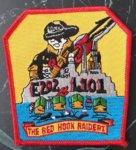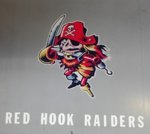You are using an out of date browser. It may not display this or other websites correctly.
You should upgrade or use an alternative browser.
You should upgrade or use an alternative browser.
FDNY and NYC Firehouses and Fire Companies - 2nd Section
- Thread starter mack
- Start date
Engine 202/Ladder 101/Battalion 32 (continued):
Engine 202/Ladder 101/Battalion 32 medals:
JULIAS W. DEJA FF. ENG. 202 DEC. 16, 1912 1913 HURLEY
The Hurley Medal was awarded to Fireman 1st Grade Julius W. Deja of Engine 202 for rescuing Fireman Michael Leddy, of Hook & Ladder 59 (now 119) from the Gowanus Canal. The fire on the Barge “Maggie Harrington” started around 5:30 P. M. on December 16, 1912. The fire had burned away the halyards permitting the boom to drop to the deck. Fireman Leddy was struck was the boom and pitched into the canal. The blow had partly stunned him and he could not have reached the dock without help. Fireman Deja jumped into the Gowanus Canal to save his brother fireman from drowning. He was dressed at the time in his heavy working outfit making his act one of great personal risk, even for a strong swimmer. Deja brought Leddy to dock and a ladder was lowered and the exhausted Leddy was lifted up to safety by his rescuer.
MARTIN J. MC NAMARA, JR. FF. LAD. 101 DEC. 18, 1918 1919 HURLEY
Fireman Martin J. McNamara of Ladder 101 received the Hurley Medal and a Department Medal for his brave act in the joint rescue of a brother fireman at a fire at 301-303 Adams Street on December 18, 1918. Smoke and gases on the 3rd floor of the building overcame probationary Fireman Charles Keller, when his commanding officer fell off the ladder to his death. Several attempts were made to reach Keller but they all failed. Fireman McNamara, undaunted climbed the ladder to the third floor through the intense heat, smoke and gases. He entered the window and with the aid of Fireman Christopher H. McGann of Engine 203, they lifted Fireman Keller to the window and with great difficulty under trying conditions brought him safely down the ladder to the street. Fireman McGann received the Crimmins Medal for assisting in the rescue.
ALEXANDER J. BROWN FF. LAD. 101 JAN. 1, 1953 1954 DELEHANTY
The M. J. Delehanty medal and a Department medal was awarded to Fireman 1st grade Alexander J. Brown of Ladder 101 for assisting in a rescue at 112 Sullivan Street on January 1, 1953. Two rear rooms of the first floor of 4-story tenement were ablaze. The extreme heat and intense smoke made the hallways and interior stairs impassable. About twenty panicstricken men, women and children were on the second floor and third floor fire escape landing. Fireman Brown along with Lieutenant John J. Connolly (2) made their way to the burning apartment. The Lieutenant ordered Brown to search the front room while Connolly search the second room. Connolly groped through the second room where he found Michael Amari unconscious. The room was blazing mass. Mr. Amari weighed over 200 pounds and with Fireman Brown’s help Lieutenant Connolly carried him from the burning apartment. After aiding Lieutenant Connolly in his rescue of Mr. Amari, Brown climbed the fire escape to the second floor and helped several persons to the street.
JOHN P. R. MCFARLAND LT. LAD. 101 L-131 MAR. 25, 1955 1956 O'DWYER
Lieutenant John P. R. McFarland of Ladder 101 rescued a child from a third-floor apartment March 25, 1955. Two rooms on the second floor were completely ablaze at 329 Union Street. Lieutenant McFarland who was detailed to Ladder 131, went to the third floor and while searching the apartment for occupants, saw a three-year old child trapped in a rear bedroom directly above the fire. McFarland brought the child to the rear fire escape. While he was climbing a ladder to the roof, intense heat, flame and smoke burst from below causing the Lieutenant to lose his grip on the ladder. He fell 40 feet to the yard but managed to protect the child in his arms from serious injury. For this rescue Lieutenant McFarland received the Mayor William O’Dwyer Medal and a Department Medal for this daring rescue.
PATRICK HICKEY BATTALION CHIEF BATT. 32 OCT. 2, 1939 1940 BONNER
The Hugh Bonner Medal was awarded to Battalion Chief Patrick Hickey of the 32nd Battalion, for participating in the rescue of two firemen from a fire at 366-70 Hamilton Avenue on October 2, 1939. Members of Engine 279 were operating a hose line in the cellar of this building until their position became untenable. Battalion Chief Hickey was with the company at the time and ordered them to withdraw. When they reached the street, he learned that two of the men were missing. He ordered Fireman William C. Dunne of Engine 279 to accompany him back into the cellar to find the missing men. In the face of intense heat, smoke and gas they searched the cellar. Fortunately they found Fireman 3rd grade and Ununiformed Fireman Joseph E. Cordes, both of Engine 279, lying unconscious in about twelve inches of water. They succeeded in carrying the unconscious men up the stairway to the street and safety. Fireman William C. Dunne received the Brooklyn Citizens’ and a Department Medal for his part of the rescue.

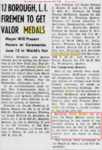
Engine 202/Ladder 101/Battalion 32 medals:
JULIAS W. DEJA FF. ENG. 202 DEC. 16, 1912 1913 HURLEY
The Hurley Medal was awarded to Fireman 1st Grade Julius W. Deja of Engine 202 for rescuing Fireman Michael Leddy, of Hook & Ladder 59 (now 119) from the Gowanus Canal. The fire on the Barge “Maggie Harrington” started around 5:30 P. M. on December 16, 1912. The fire had burned away the halyards permitting the boom to drop to the deck. Fireman Leddy was struck was the boom and pitched into the canal. The blow had partly stunned him and he could not have reached the dock without help. Fireman Deja jumped into the Gowanus Canal to save his brother fireman from drowning. He was dressed at the time in his heavy working outfit making his act one of great personal risk, even for a strong swimmer. Deja brought Leddy to dock and a ladder was lowered and the exhausted Leddy was lifted up to safety by his rescuer.
MARTIN J. MC NAMARA, JR. FF. LAD. 101 DEC. 18, 1918 1919 HURLEY
Fireman Martin J. McNamara of Ladder 101 received the Hurley Medal and a Department Medal for his brave act in the joint rescue of a brother fireman at a fire at 301-303 Adams Street on December 18, 1918. Smoke and gases on the 3rd floor of the building overcame probationary Fireman Charles Keller, when his commanding officer fell off the ladder to his death. Several attempts were made to reach Keller but they all failed. Fireman McNamara, undaunted climbed the ladder to the third floor through the intense heat, smoke and gases. He entered the window and with the aid of Fireman Christopher H. McGann of Engine 203, they lifted Fireman Keller to the window and with great difficulty under trying conditions brought him safely down the ladder to the street. Fireman McGann received the Crimmins Medal for assisting in the rescue.
ALEXANDER J. BROWN FF. LAD. 101 JAN. 1, 1953 1954 DELEHANTY
The M. J. Delehanty medal and a Department medal was awarded to Fireman 1st grade Alexander J. Brown of Ladder 101 for assisting in a rescue at 112 Sullivan Street on January 1, 1953. Two rear rooms of the first floor of 4-story tenement were ablaze. The extreme heat and intense smoke made the hallways and interior stairs impassable. About twenty panicstricken men, women and children were on the second floor and third floor fire escape landing. Fireman Brown along with Lieutenant John J. Connolly (2) made their way to the burning apartment. The Lieutenant ordered Brown to search the front room while Connolly search the second room. Connolly groped through the second room where he found Michael Amari unconscious. The room was blazing mass. Mr. Amari weighed over 200 pounds and with Fireman Brown’s help Lieutenant Connolly carried him from the burning apartment. After aiding Lieutenant Connolly in his rescue of Mr. Amari, Brown climbed the fire escape to the second floor and helped several persons to the street.
JOHN P. R. MCFARLAND LT. LAD. 101 L-131 MAR. 25, 1955 1956 O'DWYER
Lieutenant John P. R. McFarland of Ladder 101 rescued a child from a third-floor apartment March 25, 1955. Two rooms on the second floor were completely ablaze at 329 Union Street. Lieutenant McFarland who was detailed to Ladder 131, went to the third floor and while searching the apartment for occupants, saw a three-year old child trapped in a rear bedroom directly above the fire. McFarland brought the child to the rear fire escape. While he was climbing a ladder to the roof, intense heat, flame and smoke burst from below causing the Lieutenant to lose his grip on the ladder. He fell 40 feet to the yard but managed to protect the child in his arms from serious injury. For this rescue Lieutenant McFarland received the Mayor William O’Dwyer Medal and a Department Medal for this daring rescue.
PATRICK HICKEY BATTALION CHIEF BATT. 32 OCT. 2, 1939 1940 BONNER
The Hugh Bonner Medal was awarded to Battalion Chief Patrick Hickey of the 32nd Battalion, for participating in the rescue of two firemen from a fire at 366-70 Hamilton Avenue on October 2, 1939. Members of Engine 279 were operating a hose line in the cellar of this building until their position became untenable. Battalion Chief Hickey was with the company at the time and ordered them to withdraw. When they reached the street, he learned that two of the men were missing. He ordered Fireman William C. Dunne of Engine 279 to accompany him back into the cellar to find the missing men. In the face of intense heat, smoke and gas they searched the cellar. Fortunately they found Fireman 3rd grade and Ununiformed Fireman Joseph E. Cordes, both of Engine 279, lying unconscious in about twelve inches of water. They succeeded in carrying the unconscious men up the stairway to the street and safety. Fireman William C. Dunne received the Brooklyn Citizens’ and a Department Medal for his part of the rescue.


Engine 202/Ladder 101/Battalion 32 (continued):
Ladder 101 awards 1958:
LT ROBERT LUNDGREN LADDER 101 1958 Journal American Award:

LT ROBERT LUNDGREN LADDER 101 1958 NY Daily News Hero Award:

War Years Warrior :
Robert Lundgren - appointed 3/1/42, assigned to L156. Promoted to Lt. 4/1/50 assigned to L101. Promoted to Capt. 6/10/61 assigned to E248. Promoted to BC 3/16/68 assigned to B38. Promoted to Provisional DC in 1977 assigned to the 15th, then to the 13th. Passed away from lung cancer 4/15/78 while still active on the job. WWII Army Infantry, European Theater. Father of Garrett Lundgren, Rescue 3, retired.
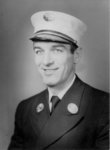
Ladder 101 awards 1958:
LT ROBERT LUNDGREN LADDER 101 1958 Journal American Award:

LT ROBERT LUNDGREN LADDER 101 1958 NY Daily News Hero Award:

War Years Warrior :
Robert Lundgren - appointed 3/1/42, assigned to L156. Promoted to Lt. 4/1/50 assigned to L101. Promoted to Capt. 6/10/61 assigned to E248. Promoted to BC 3/16/68 assigned to B38. Promoted to Provisional DC in 1977 assigned to the 15th, then to the 13th. Passed away from lung cancer 4/15/78 while still active on the job. WWII Army Infantry, European Theater. Father of Garrett Lundgren, Rescue 3, retired.

Last edited:
Engine 202/Ladder 101/Battalion 32 (continued):
Fires - 1951 2nd alarm factory fire - 20 FFs injured:
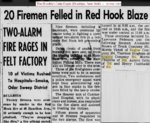
Fires - 1951 Sacred Hearts of Jesus and Mary and St. Stephen Roman Catholic Church on Hicks and Summit Streets in Red Hook - 5th alarm
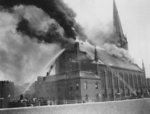
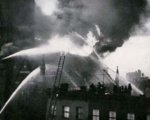
Fires - 1952 Concord Baptist Church fire:
On the evening of October 2, 1952, Concord's church on Marcy Avenue was completely destroyed by fire. 5th alarm
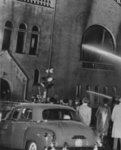
Fires: 1954 5th alarm waterfront fire:
Five-alarmer on Brooklyn waterfront: Firemen battle the five-alarm fire ripping through a block-long Brooklyn warehouse on the Erie Basin waterfront Jan. 15. Fifteen firemen were trapped briefly and rescued by other firefighters during the blaze.
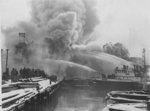
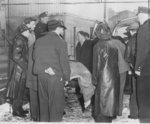
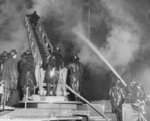
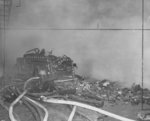
Fires - 1951 2nd alarm factory fire - 20 FFs injured:

Fires - 1951 Sacred Hearts of Jesus and Mary and St. Stephen Roman Catholic Church on Hicks and Summit Streets in Red Hook - 5th alarm


Fires - 1952 Concord Baptist Church fire:
On the evening of October 2, 1952, Concord's church on Marcy Avenue was completely destroyed by fire. 5th alarm

Fires: 1954 5th alarm waterfront fire:
Five-alarmer on Brooklyn waterfront: Firemen battle the five-alarm fire ripping through a block-long Brooklyn warehouse on the Erie Basin waterfront Jan. 15. Fifteen firemen were trapped briefly and rescued by other firefighters during the blaze.




Attachments
Last edited:
Engine 202/Ladder 101/Battalion 32 (continued):
Fires - 2 ALARM FIRE, FIREFIGHTER LODD JOHN DEVANEY 217 VAN BRUNT STREET, BROOKLYN, RED HOOK - 1989
FF John P Devaney, TL-131, lost his life on February 3rd, 1989. TL-131 responded to a fire at Box 3803, 217 Van Brunt Street in the Red Hook Section of Brooklyn. They were informed by Brooklyn Dispatch of a call reporting people trapped. FF Devaney went into a 3rd floor apartment to search for a mother and her children. He was only in the room a couple of seconds when it flashed over. The intensity of the explosive flash over (2,000 degrees), melted his facemask and incinerated him. The mother and her 2 children were found on the 4th floor. FF Devaney was only 36 years old, a 10 year veteran of the department.
Firefighter Dies As He Searches For Fire Victims
By Sarah Lyall New York Times Feb. 4, 1989
A ten-year Fire Department veteran searching a blazing Brooklyn apartment building yesterday became the first New York City firefighter killed in more than a year, the Fire Department said.
Firefighter John P. Devaney was looking for people trapped in the four-story building at 217 Van Brunt Street in the Red Hook section, when the room he was in suddenly ''flashed over,'' everything combustible in it bursting into flames, Fire Commissioner Joseph F. Bruno said.
Mr. Devaney, 36 years old, was found unconscious by other firefighters, his body covered with third-degree burns, Commissioner Bruno said. Efforts to revive him failed, and he was pronounced dead at Long Island College Hospital at 5:15 A.M.
All the residents of the building were evacuated, the Fire Department said, and four were treated for smoke inhalation and released. Another firefighter, Eneth Moore, 37, was listed in good condition at Long Island College Hospital, where he was being treated for smoke inhalation and abdominal pains.
Fire Department officials said the blaze began just before 4:00 A.M. on the building's second floor when an electrical circuit overloaded. About 80 firefighters from 20 units eventually arrived after word was received that residents were trapped inside.
As fellow members of Ladder Company 131 rescued four people from the fourth floor of the 100-year-old building, Firefighter Devaney climbed the fire escape and began to search for victims on the lower floors, Chief Bruno said. It was then that the small bedroom he was in exploded.
Fires - Box 3842 2-Alarm Fire Tears Through Red Hook Factory June 15, 2018:
Fire Location: 595 Smith St
B-32 gave the 10-75
Fire in a vacant 4 story warehouse 225 X 135 Class 6
Heavy Timber outside operation only
L-118 Fast
E-279,239,220,202
L-131,101,118(Fast)
B-32,48
R-2
Sq-1
D-11
Rac-2
Fires - 2 ALARM FIRE, FIREFIGHTER LODD JOHN DEVANEY 217 VAN BRUNT STREET, BROOKLYN, RED HOOK - 1989
FF John P Devaney, TL-131, lost his life on February 3rd, 1989. TL-131 responded to a fire at Box 3803, 217 Van Brunt Street in the Red Hook Section of Brooklyn. They were informed by Brooklyn Dispatch of a call reporting people trapped. FF Devaney went into a 3rd floor apartment to search for a mother and her children. He was only in the room a couple of seconds when it flashed over. The intensity of the explosive flash over (2,000 degrees), melted his facemask and incinerated him. The mother and her 2 children were found on the 4th floor. FF Devaney was only 36 years old, a 10 year veteran of the department.
Firefighter Dies As He Searches For Fire Victims
By Sarah Lyall New York Times Feb. 4, 1989
A ten-year Fire Department veteran searching a blazing Brooklyn apartment building yesterday became the first New York City firefighter killed in more than a year, the Fire Department said.
Firefighter John P. Devaney was looking for people trapped in the four-story building at 217 Van Brunt Street in the Red Hook section, when the room he was in suddenly ''flashed over,'' everything combustible in it bursting into flames, Fire Commissioner Joseph F. Bruno said.
Mr. Devaney, 36 years old, was found unconscious by other firefighters, his body covered with third-degree burns, Commissioner Bruno said. Efforts to revive him failed, and he was pronounced dead at Long Island College Hospital at 5:15 A.M.
All the residents of the building were evacuated, the Fire Department said, and four were treated for smoke inhalation and released. Another firefighter, Eneth Moore, 37, was listed in good condition at Long Island College Hospital, where he was being treated for smoke inhalation and abdominal pains.
Fire Department officials said the blaze began just before 4:00 A.M. on the building's second floor when an electrical circuit overloaded. About 80 firefighters from 20 units eventually arrived after word was received that residents were trapped inside.
As fellow members of Ladder Company 131 rescued four people from the fourth floor of the 100-year-old building, Firefighter Devaney climbed the fire escape and began to search for victims on the lower floors, Chief Bruno said. It was then that the small bedroom he was in exploded.
Fires - Box 3842 2-Alarm Fire Tears Through Red Hook Factory June 15, 2018:
Fire Location: 595 Smith St
B-32 gave the 10-75
Fire in a vacant 4 story warehouse 225 X 135 Class 6
Heavy Timber outside operation only
L-118 Fast
E-279,239,220,202
L-131,101,118(Fast)
B-32,48
R-2
Sq-1
D-11
Rac-2
Last edited:
Engine 202/Ladder 101/Battalion 32 (continued):
Engine 202/Ladder 101/Battalion 32 LODDs:
FIREFIGHTER JOHN CARBUSH ENGINE 202 June 8, 1905
Fireman John Carbush of Engine 102 (now Engine 202) was killed while fighting a three-alarm fire at the Bush docks located at the foot of Conover Street. Carbush and several other firemen were working on the roof of the fire building. The roof gave way tossing all into the burning cotton. Firemen Carbush and Thomas Ryan were the most seriously injured of the group. Carbush was suffering from a broken back, while Ryan suffered a fracture of the right thigh, a sprained ankle and contusions. Fireman Carbush was a fireman for eight years with a perfect record and left behind a wife and two children. He was thirty-three years old. - from "The Last Alarm"

FIREFIGHTER JAMES CASEY ENGINE 202 January 6, 1918
CAPTAIN EDWARD A. DOUGHERTY ENGINE 202 October 4, 1930
While directing the operations of the company hose line on the first floor of 69 to 71 Warren Street at this two-alarm fire, a wooden frame ceiling gave way knocking Captain Edward A. Dougherty to the floor. His left side, hip and leg landed on a wooden box or projection and his body struck the concrete floor, causing a painful and numbing feeling to the left leg and hip. Before leaving the fire, he reported the above accident and injury to the Deputy Chief of the 12th Division, Thomas R. Langford. The fire was in the basement of the Excel Furniture Company and caused $50,000 in damages before the firemen placed it under control in two hours. Captain Dougherty died in the Ruptured and Crippled Hospital in Manhattan. He was forty-eight years old, resided at 424 Clinton Street. He had been a member of the Department since 1906 and had risen in the ranks. He was on the list for Battalion Chief at the time of his death. His mother and a brother survived him. -from "The Last Alarm"
FIREFIGHTER JOSEPH DUNN ENGINE 202 November 4, 1936
FF Dunn was trapped in a burning tenament and died from gas poisoning
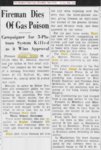
FIREFIGHTER JOHN P. SCHWINTEK ENGINE 202 February 14, 1940
New York City received 7.3 inches of snow on February 13, the most in four years. Fireman John Schwintek, of 186 Eckford Street (Greenpoint, Brooklyn), collapsed while wielding a shovel in front of Engine Company 202, 199 Van Brunt Street and was pronounced dead a short time later. - from The Last Alarm”

Engine 202/Ladder 101/Battalion 32 LODDs:
FIREFIGHTER JOHN CARBUSH ENGINE 202 June 8, 1905
Fireman John Carbush of Engine 102 (now Engine 202) was killed while fighting a three-alarm fire at the Bush docks located at the foot of Conover Street. Carbush and several other firemen were working on the roof of the fire building. The roof gave way tossing all into the burning cotton. Firemen Carbush and Thomas Ryan were the most seriously injured of the group. Carbush was suffering from a broken back, while Ryan suffered a fracture of the right thigh, a sprained ankle and contusions. Fireman Carbush was a fireman for eight years with a perfect record and left behind a wife and two children. He was thirty-three years old. - from "The Last Alarm"
FIREFIGHTER JAMES CASEY ENGINE 202 January 6, 1918
CAPTAIN EDWARD A. DOUGHERTY ENGINE 202 October 4, 1930
While directing the operations of the company hose line on the first floor of 69 to 71 Warren Street at this two-alarm fire, a wooden frame ceiling gave way knocking Captain Edward A. Dougherty to the floor. His left side, hip and leg landed on a wooden box or projection and his body struck the concrete floor, causing a painful and numbing feeling to the left leg and hip. Before leaving the fire, he reported the above accident and injury to the Deputy Chief of the 12th Division, Thomas R. Langford. The fire was in the basement of the Excel Furniture Company and caused $50,000 in damages before the firemen placed it under control in two hours. Captain Dougherty died in the Ruptured and Crippled Hospital in Manhattan. He was forty-eight years old, resided at 424 Clinton Street. He had been a member of the Department since 1906 and had risen in the ranks. He was on the list for Battalion Chief at the time of his death. His mother and a brother survived him. -from "The Last Alarm"
FIREFIGHTER JOSEPH DUNN ENGINE 202 November 4, 1936
FF Dunn was trapped in a burning tenament and died from gas poisoning

FIREFIGHTER JOHN P. SCHWINTEK ENGINE 202 February 14, 1940
New York City received 7.3 inches of snow on February 13, the most in four years. Fireman John Schwintek, of 186 Eckford Street (Greenpoint, Brooklyn), collapsed while wielding a shovel in front of Engine Company 202, 199 Van Brunt Street and was pronounced dead a short time later. - from The Last Alarm”

Engine 202/Ladder 101/Battalion 32 (continued):
Engine 202/Ladder 101/Battalion 32 LODDs:
FIREFIGHTER WILLIAM ORMSBY LADDER 101 September 7, 1931
Fireman William Ormsby, attached to Ladder 101, a member of the Department for eighteen years, died after collapsing at a fire at 98 Pioneer Street. Dr. Williams of Long Island College Hospital said death was caused by a heart attack brought on by smoke inhalation. The fire was on the roof of a two-story rooming house. Fellow firemen dragged Ormsby to the street. He was forty-two years old, married and lived at 165 State Street. – from "The Last Alarm"
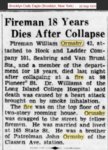
BATTALION CHIEF ANTHONY JIRECK BATTALION 32 January 27, 1945
Battalion Chief Anthony Jireck of Battalion 32 died from smoke poisoning on January 27, 1945 in fire building at 4th alarm warehouse fire.,

Chief Jireck 1904 rescue as FF:

Engine 202/Ladder 101/Battalion 32 LODDs:
FIREFIGHTER WILLIAM ORMSBY LADDER 101 September 7, 1931
Fireman William Ormsby, attached to Ladder 101, a member of the Department for eighteen years, died after collapsing at a fire at 98 Pioneer Street. Dr. Williams of Long Island College Hospital said death was caused by a heart attack brought on by smoke inhalation. The fire was on the roof of a two-story rooming house. Fellow firemen dragged Ormsby to the street. He was forty-two years old, married and lived at 165 State Street. – from "The Last Alarm"

BATTALION CHIEF ANTHONY JIRECK BATTALION 32 January 27, 1945
Battalion Chief Anthony Jireck of Battalion 32 died from smoke poisoning on January 27, 1945 in fire building at 4th alarm warehouse fire.,

Chief Jireck 1904 rescue as FF:

Engine 202/Ladder 101/Battalion 32 (continued):
Engine 202/Ladder 101/Battalion 32 LODDs:
FIREFIGHTER PATRICK BYRNE LADDER 101 September 11, 2001
FF Byrne lost his life at the World Trade Center.
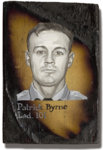

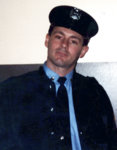
https://www.firehero.org/fallen-firefighter/patrick-d-byrne/
https://www.silive.com/september-11/2010/09/patrick_d_byrne_39_dedicated_f.html
https://911alwaysremember.wordpress.com/2018/07/29/423-patrick-d-byrne-wtc-276-firefighter/
FIREFIGHTER SALVATORE CALABRO LADDER 101 September 11, 2001
FF Calabro lost his life at the World Trade Center.
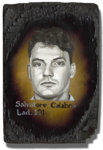

https://911alwaysremember.wordpress.com/2018/07/30/435-salvatore-b-calabro-sal-wtc-288-firefighter/

 www.firehero.org
www.firehero.org
FIREFIGHTER BRIAN CANNIZZARO LADDER 101 September 11, 2001
FF Cannizzaro lost his life at the World Trade Center.
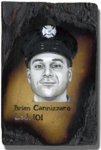
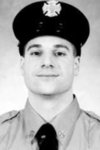
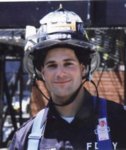

 www.silive.com
www.silive.com
https://monsignorfarrellalumni.org/brian-cannizzaro

 www.firehero.org
www.firehero.org
Engine 202/Ladder 101/Battalion 32 LODDs:
FIREFIGHTER PATRICK BYRNE LADDER 101 September 11, 2001
FF Byrne lost his life at the World Trade Center.



https://www.firehero.org/fallen-firefighter/patrick-d-byrne/
https://www.silive.com/september-11/2010/09/patrick_d_byrne_39_dedicated_f.html
https://911alwaysremember.wordpress.com/2018/07/29/423-patrick-d-byrne-wtc-276-firefighter/
FIREFIGHTER SALVATORE CALABRO LADDER 101 September 11, 2001
FF Calabro lost his life at the World Trade Center.


https://911alwaysremember.wordpress.com/2018/07/30/435-salvatore-b-calabro-sal-wtc-288-firefighter/

Salvatore Calabro - National Fallen Firefighters Foundation
Sal was born on 12/8/62 to his parents Connie and Carl. He grew up in Brooklyn‚ New York with his loving mother and two brothers. In 1980‚ he
 www.firehero.org
www.firehero.org
FIREFIGHTER BRIAN CANNIZZARO LADDER 101 September 11, 2001
FF Cannizzaro lost his life at the World Trade Center.




Brian Cannizzaro, 30, FDNY, known for his passion for life
Farrell grad followed his father into the Fire Department
https://monsignorfarrellalumni.org/brian-cannizzaro

Brian Cannizzaro - National Fallen Firefighters Foundation
By Simone Cannizzaro Brian's father On September11th‚ Brian was 30 years old. He was working the day shift at Ladder 101 in the Red Hook section of
 www.firehero.org
www.firehero.org
Last edited:
Engine 202/Ladder 101/Battalion 32 (continued):
Engine 202/Ladder 101/Battalion 32 LODDs:
LIEUTENANT JOSEPH GULLICKSON LADDER 101 September 11, 2001
LT Gullickson lost his life at the World Trade Center.
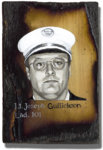
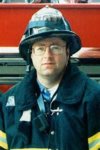
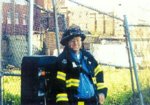

 www.firehero.org
www.firehero.org

 www.silive.com
www.silive.com
FIREFIGHTER THOMAS KENNEDY LADDER 101 September 11, 2001
FF Kennedy lost his life at the World Trade Center.
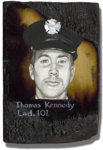
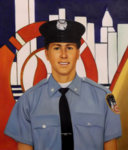

 www.firehero.org
www.firehero.org
FIREFIGHTER JOSEPH MAFFEO LADDER 101 September 11, 2001
FF Maffeo lost his life at the World Trade Center.
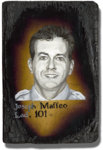


 www.silive.com
www.silive.com

 www.firehero.org
www.firehero.org
Engine 202/Ladder 101/Battalion 32 LODDs:
LIEUTENANT JOSEPH GULLICKSON LADDER 101 September 11, 2001
LT Gullickson lost his life at the World Trade Center.




Joseph P. Gullickson - National Fallen Firefighters Foundation
Joe was a 37-year-old Fire Department lieutenant at Ladder 101 in Red Hook‚ Brooklyn‚ NY. He was a devoted husband‚ father‚
 www.firehero.org
www.firehero.org

Joseph Gullickson, 37, fire lieutenant, devoted to family
History buff from West Brighton 'always looked out for his men'
FIREFIGHTER THOMAS KENNEDY LADDER 101 September 11, 2001
FF Kennedy lost his life at the World Trade Center.



Thomas J. Kennedy - National Fallen Firefighters Foundation
Thomas Kennedy was studying for the Lieutenant's test because he wanted to advance his career that he loved. Even more‚ he loved his children‚
 www.firehero.org
www.firehero.org
FIREFIGHTER JOSEPH MAFFEO LADDER 101 September 11, 2001
FF Maffeo lost his life at the World Trade Center.



Joseph Maffeo, 30, FDNY, loved spending time with son
Firefighter sold his share of a fishing boat he owned with pals to buy an engagement ring

Joseph Maffeo - National Fallen Firefighters Foundation
Joseph Maffeo‚ 30‚ firefighter‚ FDNY‚ Ladder 101. He graduated with a bachelor's degree from SUNY-Albany in 1994. When not
 www.firehero.org
www.firehero.org
Attachments
Engine 202/Ladder 101/Battalion 32 (continued):
Engine 202/Ladder 101/Battalion 32 LODDs:
FIREFIGHTER TERENCE MCSHANE LADDER 101 September 11, 2001
FF McShane lost his life at the World Trade Center.
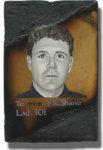
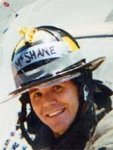

 www.firehero.org
www.firehero.org
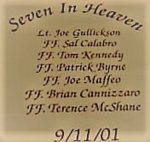
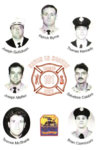
RIP. Never forget.
Engine 202/Ladder 101/Battalion 32 LODDs:
FIREFIGHTER TERENCE MCSHANE LADDER 101 September 11, 2001
FF McShane lost his life at the World Trade Center.



Terence Augustine McShane - National Fallen Firefighters Foundation
Terence Augustine McShane‚ 37‚ firefighter‚ FDNY‚ Ladder 101. McShane was a New York City police sergeant before joining the FDNY
 www.firehero.org
www.firehero.org


RIP. Never forget.
Attachments
Engine 202/Ladder 101/Battalion 32 (continued):
Engine 202 WTC-related illness death:
RETIRED FIREFIGHTER ADOLFO OTANO ENGINE 202 November 8, 2013
Retired FF Adolfo Otano died as a direct result of his exposure to WTC toxins during the course of his duties.


RETIRED FIREFIGHTER ANTHONY J. CATAPANO ENGINE 202 May 30, 2020
Retired FF Catapano died as a direct result of his exposure to WTC toxins during the course of his duties.
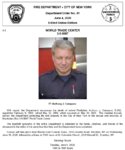
Retirement - "Veteran Firefighter Hangs Up the Hose" 05-06-2005, 12:07 PM "Firehouse"
On Sunday, May 22, Anthony Catapano will end 42 years of eating smoke. But it's not because he has had his fill.
Even after 42 years as a city firefighter, Catapano, who turns 65 the day he retires, hasn't had enough of Engine 202 in Red Hook, Brooklyn, where he has served since Nov. 3, 1963.
"I haven't made any plans," Catapano said with a grin. "I would have liked to stay a few more years, but that is not to be. But I'll be back here for lunch and dinner with these guys.
"This is a tough job to leave."
Catapano will pull two tours - read that shifts - on Saturday before ending his career on Sunday morning, his birthday.
And when he walks out of the door, Catapano also will end his stint as the longest-serving active firefighter in the department.
"I was 22 when I joined the department. The recruiter told me I could retire at 42," Catapano said. "I thought he meant 42 years on the job."
"He's in great shape, better shape than some of these guys in the firehouse," said Lt. John Malley, who serves with Catapano at Engine 202. "He gets better with age."
Born in South Brooklyn (now the Park Slope/Boerum Hill border), Catapano said his truck driver father, Anthony, steered him toward finding a city job after he finished Manual Training High School, now John Jay High in Park Slope.
So after jobs at a shipping company, as a reimbursement clerk at Chemical Bank ("I made sure other banks got their money back") and a brief stint in the Army Reserves ("I was in military intelligence; go figure," he said), Catapano and his best man, Anthony Tadduni, joined the Fire Department, persuaded in part by the idea of making $6,700 after three years on the job.
It was a different Fire Department.
The department training facilities were on Welfare Island, now Roosevelt Island. The New York City Fire Academy is now on Randalls Island.
Much of the training was done on the job - veteran firefighters took rookies under their wings and taught them how to stay alive.
"This job is built on training," Catapano said. "You have to be trained to be at 100% all of the time."
And few firefighters wore gas masks at a blaze.
"They kept the gas masks in a suitcase," Catapano said. "It took too much time to take them out of the case and put them on, especially if you were the first squad at the scene. So nobody wore them. Now they're part of your gear, right at the back of your seat in the fire truck."
One other difference between the department then and now is the present-day absence of men like Catapano - a sizable portion of today's firefighters joined the department after Sept. 11, 2001, when the World Trade Center collapse devoured 341 members of the FDNY and two FDNY paramedics.
Seven of those fallen were from Catapano's Red Hook firehouse, home of Ladder 101 and Engine 202.
"Back then there were a lot of senior men on the job who could share their experience with you. You could learn from them," Catapano said. "Now we have 5,000 men with less than three years on the job. The experience is just not here today."
What he loved and still loves about the job is the adrenaline rush, the idea of never knowing what you'll face on the job each day.
And there were many fires.
Before 9/11, Catapano remembers blazes like the one at the St. George Hotel in downtown Brooklyn.
"That was the first time I ever heard a fire going 18 alarms," he said. "That never happened before that day because there was no such thing as 18 alarms."
He remembers sitting in the firehouse and hearing several explosions. When crew members ran out to see what was happening, they saw 50-gallon drums of chemicals shooting into the air from a fire at a factory down the street.
And then there was the fire, the one that changed us all. Catapano was at the doctor's office in downtown Brooklyn, being treated for a leg injury he had received a few weeks earlier, when the planes hit the World Trade Center.
He rushed to the firehouse, where he and several other late arrivals commandeered a city bus and went to the scene, arriving after the collapse.
"We lost a lot of good men that day," he said. "I knew quite a few of them. We didn't find out until late that night that we lost seven men from this house.
"That changed the Fire Department, and changed the world."
Catapano's years on the job also helped him hone his cooking skills.
"I learned how to cook from my mom, dad and the guys at the firehouse," he said. "My specialty is whatever you want."
He means it. In 1987, Catapano and other house chefs penned "The Firehouse Cookbook" and donated all sale receipts to the burn unit of Weill Cornell Medical Center. The book sold a few hundred thousand copies and earned Catapano several appearances on the Phil Donohue show.
He said his wife, Marie, has "always been very receptive to what I do. I've been a union delegate for over 30 years, and she has put up with all the things I have to do."
He also has a son, Anthony, who is a firefighter also stationed in Brooklyn; two daughters - Audra Fox and Natalie Pelligrino - and five grandchildren.
"He's a great guy," said Vito Lepone, a retired firefighter who also visits the Richards St. firehouse regularly. "I broke him in on the job."
"I've always loved being a fireman," Catapano said. "I can count the number of days I didn't want to be here."
Notes on a career
Here are some facts about Anthony Catapano's career, courtesy of James Long in the FDNY press office:
Served with seven mayors: Robert Wagner, John Lindsay, Abe Beame, Ed Koch, David Dinkins, Rudy Giuliani and Mike Bloomberg.
Union delegate for 30 years.
Joined the department 14 months before the Mets played their first game at Shea Stadium.
Son Anthony Catapano Jr. is a firefighter in Brooklyn.
Clem Richardson
Originally published on May 6, 2005
RIP. Never forget.
Engine 202 WTC-related illness death:
RETIRED FIREFIGHTER ADOLFO OTANO ENGINE 202 November 8, 2013
Retired FF Adolfo Otano died as a direct result of his exposure to WTC toxins during the course of his duties.


RETIRED FIREFIGHTER ANTHONY J. CATAPANO ENGINE 202 May 30, 2020
Retired FF Catapano died as a direct result of his exposure to WTC toxins during the course of his duties.

Retirement - "Veteran Firefighter Hangs Up the Hose" 05-06-2005, 12:07 PM "Firehouse"
On Sunday, May 22, Anthony Catapano will end 42 years of eating smoke. But it's not because he has had his fill.
Even after 42 years as a city firefighter, Catapano, who turns 65 the day he retires, hasn't had enough of Engine 202 in Red Hook, Brooklyn, where he has served since Nov. 3, 1963.
"I haven't made any plans," Catapano said with a grin. "I would have liked to stay a few more years, but that is not to be. But I'll be back here for lunch and dinner with these guys.
"This is a tough job to leave."
Catapano will pull two tours - read that shifts - on Saturday before ending his career on Sunday morning, his birthday.
And when he walks out of the door, Catapano also will end his stint as the longest-serving active firefighter in the department.
"I was 22 when I joined the department. The recruiter told me I could retire at 42," Catapano said. "I thought he meant 42 years on the job."
"He's in great shape, better shape than some of these guys in the firehouse," said Lt. John Malley, who serves with Catapano at Engine 202. "He gets better with age."
Born in South Brooklyn (now the Park Slope/Boerum Hill border), Catapano said his truck driver father, Anthony, steered him toward finding a city job after he finished Manual Training High School, now John Jay High in Park Slope.
So after jobs at a shipping company, as a reimbursement clerk at Chemical Bank ("I made sure other banks got their money back") and a brief stint in the Army Reserves ("I was in military intelligence; go figure," he said), Catapano and his best man, Anthony Tadduni, joined the Fire Department, persuaded in part by the idea of making $6,700 after three years on the job.
It was a different Fire Department.
The department training facilities were on Welfare Island, now Roosevelt Island. The New York City Fire Academy is now on Randalls Island.
Much of the training was done on the job - veteran firefighters took rookies under their wings and taught them how to stay alive.
"This job is built on training," Catapano said. "You have to be trained to be at 100% all of the time."
And few firefighters wore gas masks at a blaze.
"They kept the gas masks in a suitcase," Catapano said. "It took too much time to take them out of the case and put them on, especially if you were the first squad at the scene. So nobody wore them. Now they're part of your gear, right at the back of your seat in the fire truck."
One other difference between the department then and now is the present-day absence of men like Catapano - a sizable portion of today's firefighters joined the department after Sept. 11, 2001, when the World Trade Center collapse devoured 341 members of the FDNY and two FDNY paramedics.
Seven of those fallen were from Catapano's Red Hook firehouse, home of Ladder 101 and Engine 202.
"Back then there were a lot of senior men on the job who could share their experience with you. You could learn from them," Catapano said. "Now we have 5,000 men with less than three years on the job. The experience is just not here today."
What he loved and still loves about the job is the adrenaline rush, the idea of never knowing what you'll face on the job each day.
And there were many fires.
Before 9/11, Catapano remembers blazes like the one at the St. George Hotel in downtown Brooklyn.
"That was the first time I ever heard a fire going 18 alarms," he said. "That never happened before that day because there was no such thing as 18 alarms."
He remembers sitting in the firehouse and hearing several explosions. When crew members ran out to see what was happening, they saw 50-gallon drums of chemicals shooting into the air from a fire at a factory down the street.
And then there was the fire, the one that changed us all. Catapano was at the doctor's office in downtown Brooklyn, being treated for a leg injury he had received a few weeks earlier, when the planes hit the World Trade Center.
He rushed to the firehouse, where he and several other late arrivals commandeered a city bus and went to the scene, arriving after the collapse.
"We lost a lot of good men that day," he said. "I knew quite a few of them. We didn't find out until late that night that we lost seven men from this house.
"That changed the Fire Department, and changed the world."
Catapano's years on the job also helped him hone his cooking skills.
"I learned how to cook from my mom, dad and the guys at the firehouse," he said. "My specialty is whatever you want."
He means it. In 1987, Catapano and other house chefs penned "The Firehouse Cookbook" and donated all sale receipts to the burn unit of Weill Cornell Medical Center. The book sold a few hundred thousand copies and earned Catapano several appearances on the Phil Donohue show.
He said his wife, Marie, has "always been very receptive to what I do. I've been a union delegate for over 30 years, and she has put up with all the things I have to do."
He also has a son, Anthony, who is a firefighter also stationed in Brooklyn; two daughters - Audra Fox and Natalie Pelligrino - and five grandchildren.
"He's a great guy," said Vito Lepone, a retired firefighter who also visits the Richards St. firehouse regularly. "I broke him in on the job."
"I've always loved being a fireman," Catapano said. "I can count the number of days I didn't want to be here."
Notes on a career
Here are some facts about Anthony Catapano's career, courtesy of James Long in the FDNY press office:
Served with seven mayors: Robert Wagner, John Lindsay, Abe Beame, Ed Koch, David Dinkins, Rudy Giuliani and Mike Bloomberg.
Union delegate for 30 years.
Joined the department 14 months before the Mets played their first game at Shea Stadium.
Son Anthony Catapano Jr. is a firefighter in Brooklyn.
Clem Richardson
Originally published on May 6, 2005
RIP. Never forget.
Last edited:
Engine 202/Ladder 101/Battalion 32 (continued):
Red Hook:
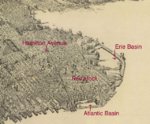



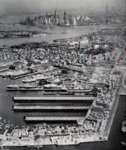
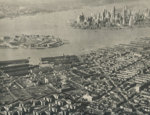
Red Hook history:
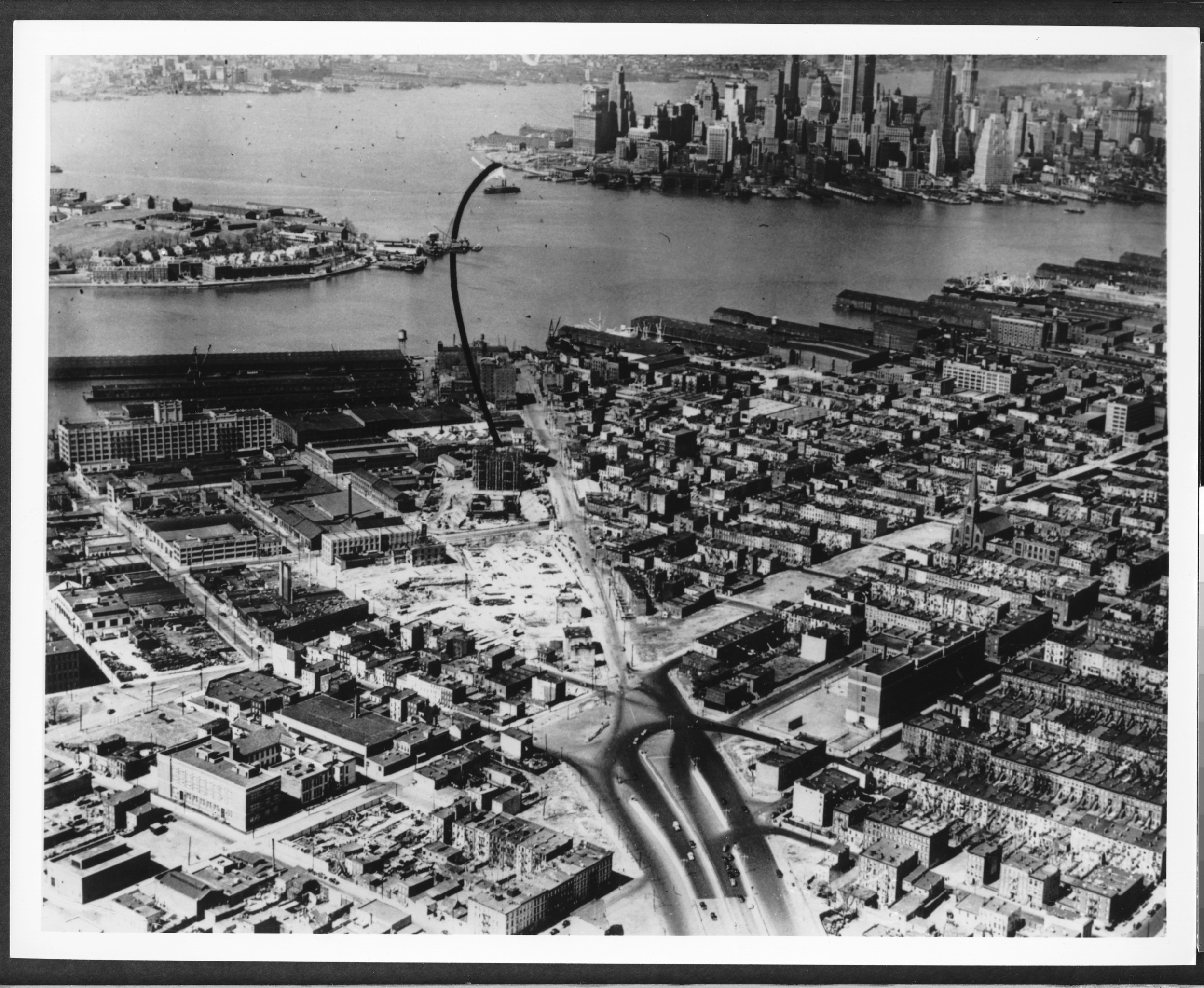
 www.bklynlibrary.org
www.bklynlibrary.org
Red Hook ferry to Manhattan:
The Hamilton Avenue Ferry was established in 1846 by the Union Ferry Company. The Hamilton Avenue Ferry service to Manhattan was the only mass transit option to and from Red Hook. New York City began running the Hamilton Avenue Ferry as a public service in 1922. The Ferry was closed in 1943 due to declining ridership.


Red Hook:
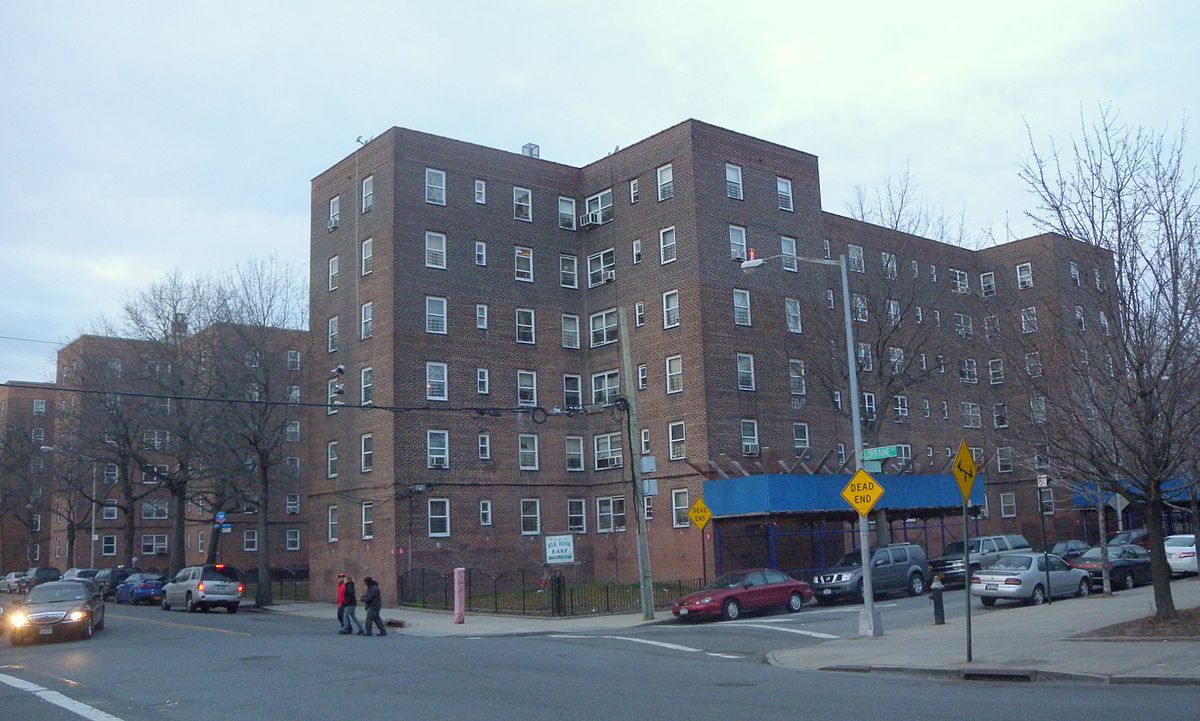
 en.wikipedia.org
en.wikipedia.org
Red Hook:






Red Hook history:

A (Not So) Brief History of Red Hook
Shipyards, dry docks, and machine shops. The place with the IKEA and the Fairway. Home of the fabled wild dogs on Beard St. and the abandoned grain elevator. Former home of the Dell's Maraschino Factory and the Snapple Factory. A Brooklyn neighborhood with a "small town" feel, cobbled streets...
Red Hook ferry to Manhattan:
The Hamilton Avenue Ferry was established in 1846 by the Union Ferry Company. The Hamilton Avenue Ferry service to Manhattan was the only mass transit option to and from Red Hook. New York City began running the Hamilton Avenue Ferry as a public service in 1922. The Ferry was closed in 1943 due to declining ridership.


Red Hook:

Red Hook, Brooklyn - Wikipedia
Last edited:
Engine 202/Ladder 101/Battalion 32 (continued):
188 Van Brunt Street former firehouse - "Friends of Firefighters"
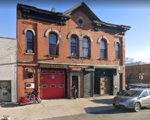

Friends of Firefighters:
Our mission and services
Friends of Firefighters is a 501(c)3 not-for-profit organization dedicated to providing free, confidential mental health and wellness services to New York City's active and retired firefighters and their families. We are headquartered in a revitalized firehouse in Red Hook, Brooklyn with satellite counseling offices throughout the city and Long Island. Over the past 19 years, our organization has expanded to meet the growing needs of the FDNY community by providing a range of peer support programs, financial guidance, expert counseling, and wellness services, all of which are offered by a team of professional staff sensitive to and knowledgeable about the firefighter culture. It has been and continues to be our mission to remove as many barriers to mental health and wellness services as possible so that this community can best be supported.
Our Story
Thousands of active and retired firefighters responded to the alarm and 343 members of the Fire Department of New York (FDNY) perished in the collapse of the World Trade Center towers on September 11, 2001. Friends of Firefighters was born within days of this catastrophic event through the performance of several unobtrusive acts of kindness offered by the local community. These ranged from making dinners for exhausted rescue workers, to coordinating and facilitating "behind the scenes" in a variety of ways for funerals and memorials, to sitting and listening to firefighters talk over a cup of coffee.
Firefighters face trauma every day, impacting their physical and mental health, as well as that of their families, even long after retirement. We understand the common effects of the job such as stress, anxiety, insomnia, injury and sickness, strains on relationships and family life, loneliness after retirement or struggles with addiction. We also know that it can be hard to ask for help, especially for a community who is used to helping others.
https://friendsoffirefighters.org/
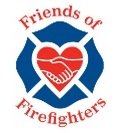
188 Van Brunt Street former firehouse - "Friends of Firefighters"


Friends of Firefighters:
Our mission and services
Friends of Firefighters is a 501(c)3 not-for-profit organization dedicated to providing free, confidential mental health and wellness services to New York City's active and retired firefighters and their families. We are headquartered in a revitalized firehouse in Red Hook, Brooklyn with satellite counseling offices throughout the city and Long Island. Over the past 19 years, our organization has expanded to meet the growing needs of the FDNY community by providing a range of peer support programs, financial guidance, expert counseling, and wellness services, all of which are offered by a team of professional staff sensitive to and knowledgeable about the firefighter culture. It has been and continues to be our mission to remove as many barriers to mental health and wellness services as possible so that this community can best be supported.
Our Story
Thousands of active and retired firefighters responded to the alarm and 343 members of the Fire Department of New York (FDNY) perished in the collapse of the World Trade Center towers on September 11, 2001. Friends of Firefighters was born within days of this catastrophic event through the performance of several unobtrusive acts of kindness offered by the local community. These ranged from making dinners for exhausted rescue workers, to coordinating and facilitating "behind the scenes" in a variety of ways for funerals and memorials, to sitting and listening to firefighters talk over a cup of coffee.
Firefighters face trauma every day, impacting their physical and mental health, as well as that of their families, even long after retirement. We understand the common effects of the job such as stress, anxiety, insomnia, injury and sickness, strains on relationships and family life, loneliness after retirement or struggles with addiction. We also know that it can be hard to ask for help, especially for a community who is used to helping others.
https://friendsoffirefighters.org/



